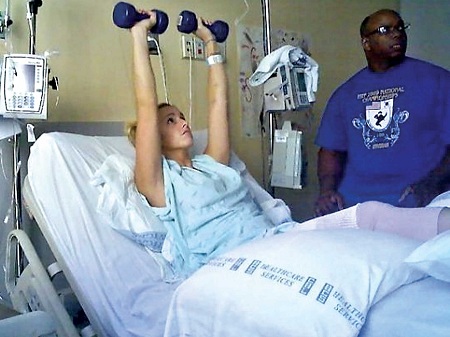I shall tell you of Ali McWeeny. 
In 2009, Ali was a junior at Central Washington who won the school strong woman contest, held 22 Washington state powerlifting records, and was an accomplished thrower on the track and field team. Most importantly, she was working towards a degree in physical education, a career goal that would let her share her passion for sport and an active lifestyle with young students.
On July 4th, 2009, the boat Ali was riding in was capsized by a wave and she was thrown from the boat. The propeller did a toll on her left leg, and her left leg was amputated. How depressing of a scenario for a young woman who loves to be active, strong, and fit. Seemed like her powerlifting and teaching aspirations were over, right?
Ali McWeeny is stronger than that.
She sat in her hospital bed with morphine pumping through her body. And she trained. She lifted 8 pound dumbbells because what else is she going to do? Lay down and die? Ali McWeeny is stronger than that.
Three years later and Ali has graduated with her physical education degree with a coaching minor. She’s competed in powerlifting, the only woman in the world to do so on one leg without a prosthesis. In the 125 lbs class she has squatted 104, benched 172, and deadlifted 204 (see below).
But it’s not enough; Ali McWeeny is stronger than that.
She wants to deadlift 250 pounds (at this year’s Night of the Living Dead). She wants to play and compete in winter sports like snowboarding, alpine skiing, telemark skiing, cross country skiing, and snow skiing! She wants to do motor sports like motor cross, trail riding, and snow mobiling! She wants to water ski, wakeboard, wind surf, kite board, scuba dive, swim, and surf! She wants to experience the world and push her limits, and damned if she only has one leg! Oh yes, Ali Mcweeny is stronger than that.
But she needs our help.
A new prosthetic that would make all of this possible — one that would make movement and rehab more efficient — costs right under $7,000. She’s raising money for this new prosthetic HERE. I’ll be damned if 70’s Big doesn’t help her raise this money. She’s already halfway there, so let’s bring her home. I’ve already donated, so drop a few bucks in the account and let’s give her our support. Try and watch this video and NOT pull for her.
Ali McSweeny shows us that no matter what the circumstance, no matter how bad things seem, you always have breath left in you. Each day is an opportunity to go out and attack life. Turn your back on the prospect of being a sniveling mess and stride forward, leg or no leg, to push your potential. Until that moment in which death has become you, never stop. For if you do, know that there’s a woman who is stronger than that who steps into the fray each day.
Once more into the fray…
Into the last good fight I’ll ever know.
Live and die on this day…
Live and die on this day…



